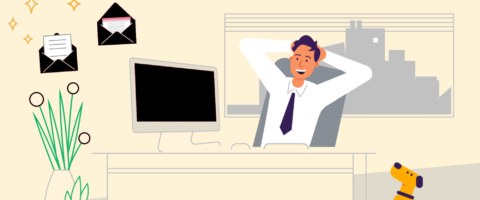
By David Battson 11 min read

Email marketing has caught the attention of nearly every business across western society. According to Smart Insights, the very first email marketing campaign was sent in 1978 by Gary Thuerk and resulted in nearly $13 million worth of sales from just 400 users!
As the years passed and the introduction of the internet emerged in 1991 the use of this channel for direct marketing has soared. This revolutionary technology transformed communication globally and a phased transition from traditional post and mail to electronic emails began to take form.
In 2020, approximately 306.4 billion emails were sent and received each day worldwide and this is predicted to grow further to 361.6 billion in 2024 (Statista, 2020). Examining this further it can also be noted that the number of global email users has increased year on year with an estimate 4.04 billion recorded in 2020 (Statista, 2020). Such a large global audience emphasises the opportunity to capture the attention of prospects and customers through this channel.
Applying research and our expertise we will be examining some of the crucial steps you must take to deploy a perfect marketing campaign in 2021.
Creating an Email Marketing Plan
The first step in any marketing campaign is to create a marketing plan that complements the strategic direction of the business and maximises its potential. A marketing strategy refers to the businesses overall game plan to reach prospective consumers and turn them into customers of a business’s services or products. Most often, a business will devise a partial strategy in their marketing effort but overlook a marketing plan.
However, this can lead to a loss in communication between management and the employees of an organisation (depending on its size and structure) and could potentially lead to misdirection and ineffective campaigns. A marketing plan should be documented and outline critical information, including the type of marketing activity, long-term and short-term goals, target sectors, target audience, timelines, and audience segmentation.
Defining Your Audience
No matter what a company is selling it is vital to have a clear understanding of your audience to effectively communicate to them. This may seem like an easy task, but it can be neglected or not analysed deeply enough. To do this it is vital to establish the target market that will be using the services or products and then profile a target audience that has purchasing power. For B2C campaigns, the data that is imperative to gather at this stage is age, gender, education, class, location, and consumption habits. In the B2B world, it is very similar but instead the data you must gather (or have it appended) is industry, employee size, turnover, location, premise type, credit worthiness as well as purchasing history.
Segmenting and Grouping
Segmenting your audience adds more value and is made up of subgroups of the overall audience. In 2019 a study found that 90% of U.S consumers found marketing content personalisation ‘very’ or ‘somewhat’ important (Statista, 2019) and 63% of consumers will stop buying from a brand that uses poor personalisation tactics (Forbes, 2020). These two studies demonstrate that consumers have become further empowered and increasingly expect personalisation from brands, thus indicating that segmentation will be crucial in 2021.
To achieve this, discover your target markets behaviours, lifestyle interests, and psychographics. This technique also crosses-over into the B2B Marketing environment. As the old saying goes, "people buy from people" and so it's important your communications treat the decision makers as people. These are fundamental topics to understand in a marketing plan if you are going to execute personalised marketing effectively.
Setting Measurable Goals
Considering what the email campaign is going to achieve is a vital part of the marketing plan. Asking questions such as ‘do we want these emails to drive sales or engagement?’ will help narrow a realistic outcome for the campaign.
Once you understand why you need an email campaign it is a good idea to set up goals. For example, the email campaign could have simple goals that are easy to measure such as the following:
- Increase the open rate of emails by 50% in 8 months
- Expand the email list by 30% in the next quarter
- Drive conversion rates by measuring the subscribers within a certain period
Notice how these goals encompass a simple acronym known as SMART (Simple, Measurable, Achievable, Realistic and Time-based) to determine a realistic and measurable goal with a timeline. The next step is to assign stakeholders or anyone that is regularly involved in the campaign a responsibility to avoid complications or misunderstandings. We suggest that you determine the following:
- Who is monitoring the campaign?
- Who is writing the copy?
- Who is reviewing the testing processes?
- Who will be reporting on the campaign?
Answering these questions now rather than later will save time and money further down the line and benefits everyone involved in the project.
Building an Email List
Sign up sources provide some of the most valuable data as to where and how people subscribed. To increase volume quickly there are numerous ways to seek a professional and extensive email list. Our dedicated data experts will identify which mailing lists best suits your campaign and can send them to you in a custom format at the speed you desire.
Knowing where customers have joined can give you a better understanding of how to communicate with customers and where to focus marketing efforts. For example, if most sign-up forms have been generated from sharing across social media, it may be best to connect with the lead via a social platform.
Deciding What to Write
When the above steps have been completed it is time to put pen to paper or get the keyboard out and start writing enticing copy that will hook readers and meet the campaigns objective. Email copywriting can be time consuming and should be completed individually to manage the task effectively. The email should have a purpose and resonate to subscribers, so it is important to keep in mind where they came from.
As previously mentioned, customers expect emails to be personalised, therefore overlooking this can damage the brand and impact the success of the campaigns. With the right use of data and technology it is now easy to personalise an entire email creative according to an individuals recipients transactional history or profiled expectations. Here are some fundamental components that emails should contain to increase the chance of them being opened.
- From name - Writing emails that are attempting to engage a reader means that the sent from section ideally should be a friendly email address. Simply changing from ‘no-reply’ to ‘customer-success’ or a personal email address will increase the likelihood of the email being opened.
- Subject line - This is the first part of the email most users will see so it pays to give it special attention. Highlight something important here that will interest the reader.
- Preview text - The preview text is an excellent way to expand on the subject line and give a reason for users to open the email. The use of ellipsis to suggest a discount or an exclusive deal for example can be highly effective regarding email open rate.
- Body - This is the copy that will be in the email to achieve the objective of the campaign. It is crucial in this step to have agreed upon headlines, copy, and call to actions so that not only will the reader be happy with the content but also open future emails from the business. We recommend writing the body of the copy first, followed by the headline and call to actions. It is imperative each email is specific to the target audience and focuses on the key benefit to the reader. Remember if the reader has no compelling reason to open the email then they will most likely avoid all future emails.
- Images - Images are a key component of an email and provide a visual experience for the reader. All the images used in an email need to be relevant and enhance the experience of the recipients.
Tips for Successful Email Campaigns
Creating unique and engaging content can be tough and the competition is fierce. Yet, we have discovered that there are some great tips for creating and gathering content that aligns with the marketing campaign and will be highly relevant to readers.
- Facilitating exclusivity for members - Value each subscriber for being a part of the business and offer exclusive offers, discounts, or even experiences so that they feel extra special. Creating an email that gets customers looking forward to your emails is hard to do but through this technique, subscribers will be excited to receive emails from your company.
- Making it useful - There is no benefit to a campaign if the content of the email does not evoke any emotion from the reader. If customers are to spend their time reading the email, there must be a clear reason and incentive for them. Get to the point and make it short and sweet.
- Make it personable - If there is one thing our readers need to take from this article it is that personalisation will be critical for businesses in 2021.
Review, Test and Send the Campaign
After the email copy is complete and ready it is time to review, test and send. Check over the copy for grammatical errors, spelling mistakes and the tone of your writing. Having members of the marketing team help proofread, check over links, and review the overall format via a test email is highly recommended. An important factor to consider in this phase is if the emails are optimised for mobile. In 2017 an estimated 47.42% of emails were opened on mobile devices in the UK and this is expected to grow over the years (Statista, 2020).
Once the email has been agreed by the relevant individuals it is time to send or schedule them. Scheduling emails is extremely useful for marketing departments because there are optimal times of the day that people are likely to notice and read emails. Certain days and times of the week will likely see a boost in engagement for some campaign types and should be discussed by the team.
A/B Testing
We recommend that email marketing campaigns use A/B testing to maximise the success of a campaign. A/B testing is an example of statistical hypothesis testing, whereby the relationship of two separate data sets is compared against each other to determine a correlation or significant difference in the data gathered (Conversation Science, 2020). This technique is used in marketing to measure the success rate of a campaign and can be employed to test the effectiveness of emails. For example, two campaigns that are completely the same could be tested at different times to see what works best.
Measuring Results
Once the emails have been sent or scheduled it is time to prepare for the measuring part of the campaign. Email campaigns need to be reflected upon and evaluated to improve future campaigns and report on their success. Factors such as CRT (Click Through Rate) and unique opens need to be recorded to gather a detailed picture of the performance of the campaign.
In addition, try to put in processes to understand what happens post generating clicks and opens on your campaigns. If possible use tagging or software to understand the user journey from click through the website. Being able to translate clicks and opens through to sign-ups, sales and revenue is the ultimate acid test for any campaign.
When to Use Email Marketing
Email marketing is highly effective and when utilised correctly will deliver positive results. Here are some of the most common ways to use email marketing, including the best tactics to maximise its potential.
- Connecting with customers - Reaching out and building a relationship through personalised emails can boost engagement and brand value for the business.
- Boost brand awareness - By not letting people forget what your brand offers it will reaffirm in the mind of the prospect who the company is and what they offer.
- Curate leads - Capture the attention of recipients to provide data that can be used in future marketing campaigns.
- Promoting content - Use emailing to share relevant blogs and information to prospects.
- Retain customers - After the business has acquired a subscriber/customer it is important not to lose them. Delight customers with tailored content that helps them reach their goals and value being a part of your business.
- Promoting products or services - The most obvious use of email marketing is to promote the services and products the business offers. You can complement this with discount offers or exclusive coupons to create a sense of urgency and encourage a purchasing decision.
The Benefits of Email Marketing
As previously mentioned in the introduction the global audience of email users worldwide is huge and poses a lot of opportunities to capture sales. If the size of the audience does not grab the attention of our avid readers, then we are sure the other benefits below will be a pause for thought:
- Email is 40X more effective than Facebook and Twitter combined (Forbes, 2013).
- Emailing is cost efficient and a great way to nurture leads.
- The average open rate for a welcome email is 82%
- It is estimated that ROI on email marketing is over 1000% on average.
Time to Make Your Email Campaign
With the information outlined above, you can now begin creating a professional email marketing campaign. Remember that it is imperative to consider the marketing strategy and plan before formulating the email itself.
Applying the statistical data from research and our experience we are confident that following the steps covered will give your campaigns a competitive edge and deliver exceptional results in 2021.
If you are interested in discovering what Data HQ can offer to your email marketing campaigns, please contact us today and a member of our friendly team will happily help!
Related blogs and ideas
Explore more ideas
Let us open your mind to new possibilities
Our stories and ideas direct to your inbox





